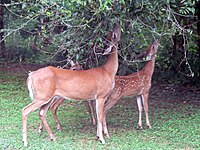
Photo from wikipedia
Flower plantings can increase the abundance of bees and improve pollination services in the surrounding landscape. However, uncertainty remains as to whether flower plantings play a role in wild bee… Click to show full abstract
Flower plantings can increase the abundance of bees and improve pollination services in the surrounding landscape. However, uncertainty remains as to whether flower plantings play a role in wild bee conservation. The aim of this study has been to examine the contribution of the composition and management of flower plantings to the attraction of bees, particularly of endangered species. In a large-scale monitoring project, wild bee data were collected on 60 flower plantings and 120 semi-natural reference plots in 20 study sites over 2 years. In total, we recorded 60,335 bees belonging to 351 species. In flower plantings, bee species richness and abundance were intricately linked to high plant richness and constant blooming throughout the season. In the first year of this study, a complimentary blooming phenology of annual and perennial plants resulted in a more constant bloom on flower plantings. In the second year, partial mowing of flower plantings mid-season enhanced floral resources during the late season. As a result, bee richness and abundance in flower plantings increased from the first to the second year. Nevertheless, the compositional heterogeneity of bees over all 20 sites in Germany did not increase from the first to the second year. We conclude that diverse and constant blooming throughout the season is the most important factor for promoting bees in flower plantings. To ensure sufficient beta diversity over a large spatial scale, we recommend the adjustment of seed mixtures according to the geographical region.
Journal Title: Biodiversity and Conservation
Year Published: 2021
Link to full text (if available)
Share on Social Media: Sign Up to like & get
recommendations!